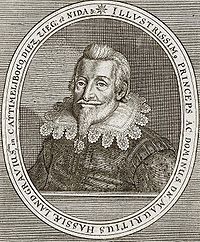Maurice, Landgrave of Hesse-Kassel
| Maurice | |
|---|---|
| Landgrave of Hesse-Kassel | |

Portrait of Maurice of Hesse-Kassel from the work Theatrum Europaeum (1662).
|
|
| Spouse(s) |
Agnes of Solms-Laubach Juliane of Nassau-Dillenburg |
|
Issue
Otto, Hereditary Prince of Hesse-Kassel
Elisabeth, Duchess of Mecklenburg William V, Landgrave of Hesse-Kassel Philipp Agnes, Princess of Anhalt-Dessau Herman IV, Landgrave of Hesse-Rotenburg Magdalene, Countess of Salm-Reifferscheid Sophie, Countess of Schaumburg-Lippe Frederick, Landgrave of Hesse-Eschwege Christian Ernest, Landgrave of Hesse-Rheinfels |
|
|
Titles and styles
The Landgrave of Hesse-Kassel
|
|
| Noble family | Hesse-Kassel |
| Father | William IV, Landgrave of Hesse |
| Mother | Sabine of Württemberg |
| Born | 25 May 1572 Kassel, Hesse-Kassel |
| Died | 15 March 1632 (aged 59) Eschwege, Hesse-Kassel |
Maurice of Hesse-Kassel (German: Moritz) (25 May 1572 – 15 March 1632), also called Maurice the Learned, was the Landgrave of Hesse-Kassel (or Hesse-Cassel) in the Holy Roman Empire from 1592 to 1627.
Maurice was born in Kassel as the son of William IV, Landgrave of Hesse-Kassel, and of his wife Sabine of Württemberg.
Although Maurice had been raised in the Lutheran faith, he converted to Calvinism in 1605. On the principle Cuius regio eius religio, Maurice's subjects were also required to convert to Calvinism. Maurice's conversion was controversial since the Peace of Augsburg had only settled religious matters betweens Roman Catholics and Lutherans and had not considered Calvinists. Maurice tried to introduce Calvinism to the lands which he had inherited from the extinct Hesse-Marburg branch of his family. Such a change of faith was contrary to the inheritance rules, and resulted in an ongoing conflict with the Hesse-Darmstadt branch. It also brought him into conflict with the Holy Roman Emperor, Matthias.
English strolling players ('Die Englische Comoedianten') were frequent visitors to, and performers in, towns and cities in Germany and other European countries, including Kassel, during the 16th and 17th centuries. Landgraf Moritz (to use his German nomenclature) was a great supporter of the performing arts and even built the first permanent theatre in Germany, named the Ottoneum, in 1605. This building still exists today but as a Natural History Museum.
...
Wikipedia
